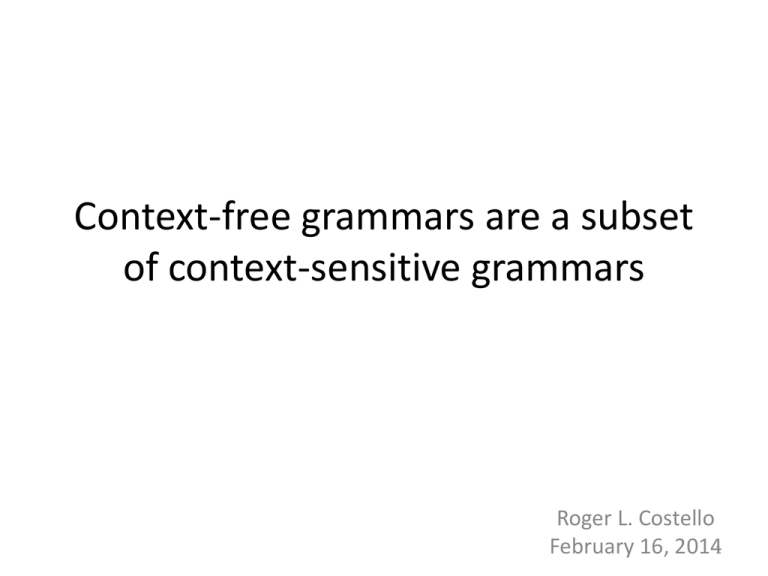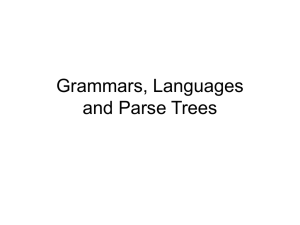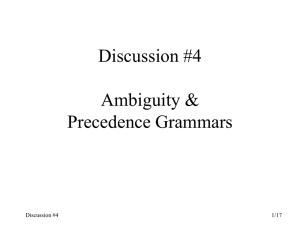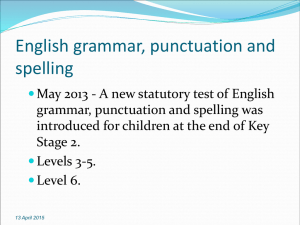Context-free grammars are a subset of context-sensitive
advertisement

Context-free grammars are a subset
of context-sensitive grammars
Roger L. Costello
February 16, 20141
Objective:
Show that Type 2 is a subset of Type 1
2
Grammars: a brief refresher
• A grammar is a concise way to specify a language.
• A language is a set of strings.
Example: This is an (infinite) language: {a, aa, aaa, …}
• A grammar consists of a series of (rewrite) rules.
• Each rule has a left-hand side and a right-hand
side. The two sides are separate by an arrow (→).
3
Sample Grammar
The below grammar consists of five rules. The
grammar generates the language:
{ab, aab, abb, aaab, aaabb, aaabbb, …}
S → AB
A → aA
A→a
B → bB
B→b
4
Generate a string from the grammar
Grammar
S → AB
A → aA
A→a
B → bB
B→b
Here is a sequence of rules to generate: aab
S → AB
→ aAB
→ aaB
→ aab
5
Rules with “alternates”
Grammar
S → AB
A → aA
A→a
B → bB
B→b
• Notice in the above grammar there are two rules for A. Ditto for B.
• The two rules may be combined: the right-hand side will consist of
a series of alternatives, separated by a vertical bar ( | ):
Grammar
Equivalent Grammar
S → AB
A → aA
A→a
B → bB
B→b
S → AB
A → aA | a
B → bB | b
combine A’s
combine B’s
6
“Zero” or more a’s and b’s
Grammar
S → AB
A → aA | a
B → bB | b
• The above grammar requires every string in
the language contain at least one a and at
least one b.
• What grammar would generate the language:
zero or more a’s followed by zero of more b’s?
7
Generate an empty string
• Question: What grammar would generate the
language: zero or more a’s followed by zero of
more b’s?
• Answer: Use rules that generate an empty
string (a string of length zero).
• We denote an empty string by: ε
• This grammar generates the desired language:
Grammar
S → AB
A → aA | ε
B → bB | ε
8
Generate both empty and non-empty
This rule for A generates both empty and nonempty:
A → aA | ε
empty
non-empty
9
How to read a rule
A → aA | ε
Read as: A may be replaced by aA or by an empty string.
The arrow (→) is read as: may be replaced by.
10
Terminal versus non-terminal symbols
A → aA | ε
Non-terminal symbols; these
are symbols that may be
replaced (further expanded).
Terminal symbols; these are
symbols that may not be
replaced.
11
Notation
• Non-terminal symbols: denoted by uppercase
letters.
Example: Q1, Q2, A, P, S denote non-terminal
symbols
• Terminal symbols: denoted by lowercase
letters.
Example: a, b, c denote terminal symbols
12
Context-sensitive grammars
Every rule has this form:
context
context
Q1AQ2 → Q1PQ2
A is replaced by P
13
Context-sensitive grammars
• Every rule has this form:
Q1AQ2 → Q1PQ2
• That is, some symbol A is rewritten to some
symbol P while the surrounding (context)
symbols Q1 and Q2 remain unchanged.
Note: P can be multiple symbols.
14
Context-sensitive grammars
• Every rule has this form:
Q1AQ2 → Q1PQ2
• That is, some symbol A is rewritten to some
symbol P while the surrounding (context)
symbols Q1 and Q2 remain unchanged.
Note: P can be multiple symbols.
• A must be a non-terminal. Q1, Q2, and P are
either non-terminals or terminals.
15
Context-sensitive grammars
• Every rule has this form:
Q1AQ2 → Q1PQ2
• That is, some symbol A is rewritten to some
symbol P while the surrounding (context)
symbols Q1 and Q2 remain unchanged.
Note: P can be multiple symbols.
• A must be a non-terminal. Q1, Q2, and P are
either non-terminals or terminals.
• P must not be empty (ε).
16
Context-sensitive grammars
• Every rule has this form:
Q1AQ2 → Q1PQ2
• That is, some symbol A is rewritten to some symbol P
while the surrounding (context) symbols Q1 and Q2
remain unchanged.
Note: P can be multiple symbols.
• A must be a non-terminal. Q1, Q2, and P are either
non-terminals or terminals.
• P must not be empty (ε).
• None of the rules lead to empty except possibly for a
rule S → ε, in which case S does not occur on the
right-hand side of any rules.
17
Sample context-sensitive rule
empty
context
S → abc
S is replaced by abc
18
Sample context-sensitive rule
empty
context
S → aSQ
S is replaced by aSQ
19
Sample context-sensitive rule
context
bQc → bbcc
Q is replaced by bc
20
Sample context-sensitive rule
empty
right
context
cQ → cc
Q is replaced by c
21
Sample context-sensitive rule
empty
left
context
cc → Qc
c is replaced by Q
22
Swap c and Q
cQ → cc
cc → Qc
Collectively, the two rules swap c and Q.
23
Sample context-sensitive grammar
The language generated by the below contextsensitive grammar is: anbncn
Grammar for anbncn
S → abc | aSQ
1.
2. bQc → bbcc
3. cQ → cc
cc → Qc
4.
24
Generate a string from the grammar
Grammar for anbncn
Derivation of a3b3c3
S → abc | aSQ
1.
2. bQc → bbcc
3. cQ → cc
cc → Qc
4.
S
aSQ
aaSQQ
aaabcQQ
aaabccQ
aaabQcQ
aaabbccQ
aaabbccc
aaabbQcc
aaabbbccc
(start)
(rule 1)
(rule 1)
(rule 1)
(rule 3)
(rule 4)
(rule 2)
(rule 3)
(rule 4)
(rule 2)
generated string
25
Next on the agenda
• We have seen what context-sensitive
grammars look like, and the restrictions
imposed on them (e.g., the P in the right-hand
side can’t be empty).
• Now let’s turn our attention to context-free
grammars.
26
Context-free grammars
Every rule has this form:
empty
context
A→P
A is replaced by P
27
Context-free grammars
• Every rule has this form:
A→P
• That is, some symbol A is rewritten to some
symbol P.
A never has context – it is context-free!
P can be multiple symbols
28
Context-free grammars
• Every rule has this form:
A→P
• That is, some symbol A is rewritten to some
symbol P.
A never has context – it is context-free!
P can be multiple symbols.
• A must be a non-terminal. P is any sequence
of non-terminals and terminals.
29
Context-free grammars
• Every rule has this form:
A→P
• That is, some symbol A is rewritten to some
symbol P.
A never has context – it is context-free!
P can be multiple symbols.
• A must be a non-terminal. P is any sequence
of non-terminals and terminals.
• P may be empty (ε).
30
Next on the agenda
• Now we have seen context-sensitive
grammars and context-free grammars.
• Now it’s time to compare them.
31
Compare the two types of grammars
Context-sensitive
context
Context-free
context
Q1AQ2 → Q1PQ2
A is replaced by P
empty
context
A→P
A is replaced by P
A context-free rule is a context-sensitive
rule without context, so context-free is a
subset of context-sensitive; right?
32
Key Point
The P in a context-sensitive rule cannot
be empty whereas the P in a context-free
rule can be empty. So it is not an applesto-apples comparison and we cannot
claim that context-free is a subset of
context-sensitive.
33
Context-free has an additional value
Context-sensitive
Q1 A Q2
Q1 P Q2
Context-free
A
P
ε
34
What is needed?
• What do we need to make the claim that a
context-free rule is a special case (subset) of a
context-sensitive rule?
35
Context-free without an empty P
• If we can show that, for every context-free
grammar there is an equivalent grammar that
doesn’t have an empty P, then we will have an
apples-to-apples comparison.
36
Need to show this
Context-free rule with ε
P
A
ε
transform to an equivalent
grammar
Equivalent context-free rule without ε
A
P’
37
2-step strategy
1. Use a systematic procedure (i.e., algorithm)
to find all the non-terminal symbols that
generate empty (ε).
2. Modify the grammar rules: eliminate the
non-terminals found in step 1 and then
modify the rules that use the eliminated nonterminals.
38
A generates empty
A→ε
39
A generates empty and non-empty
A→ε|a
40
B generates empty
A→ε
B→A
41
Procedure
1. Find the non-terminals that directly generate
empty, i.e., those of this form: X → ε
2. Then find the non-terminals which have on their
right-hand side exclusively symbols found in step 1,
e.g., Y → X
3. Then find the non-terminals which have on their
right-hand side exclusively symbols found in step 1
or step 2
4. Repeat until no new non-terminals are found.
42
Closure algorithm
• The procedure described on the previous slide
is called a closure algorithm.
• We will find all the non-terminal symbols that
produce empty (ε) by using a closure
algorithm.
43
2 steps to identify the non-terminals
Our closure algorithm identifies non-terminals
that generate empty using these two steps:
1. Initialization:
• If a rule has ε on its right-hand side, then the rule’s lefthand side non-terminal generates empty.
2. Inference rule:
• If all the right-hand side members of a rule produce
empty, then the rule’s left-hand side non-terminal
produces empty.
44
Which non-terminals generate empty?
Let’s use the closure algorithm on the below
grammar. The closure algorithm finds all the
non-terminals that generate empty.
S
S
A
A
B
C
D
→
→
→
→
→
→
→
AB
C
ε
a
A
AD
d
Goal: Find the non-terminals that
generate empty (ε)
45
Round 1 (Initialization)
Rule
Produces empty?
S → A B
S → C
A → ε
A produces empty
A → a
B → A
C → A D
D → d
46
Round 2 (inference)
Rule
Produces empty?
S → A B
S → C
A → ε
A produces empty
A → a
B → A
B produces empty (because A produces empty)
C → A D
D → d
47
Round 3 (inference)
Rule
Produces empty?
S → A B
S produces empty (because A and B produce empty)
S → C
A → ε
A produces empty
A → a
B → A
B produces empty (because A produces empty)
C → A D
D → d
48
Round 4
Round 4 adds no additional members to the set.
Rule
Produces empty?
S → A B
S produces empty (because A and B produce empty)
S → C
A → ε
A produces empty
A → a
B → A
B produces empty (because A produces empty)
C → A D
D → d
49
Non-terminals that generate empty
S
S
A
A
B
C
D
→
→
→
→
→
→
→
AB
C
ε
a
A
AD
d
Non-terminals that generate empty: {A, B, S}
50
Make the grammar
context-sensitive-compliant
Our goal is to modify the grammar so that it is a
context-sensitive grammar.
It will be both context-sensitive and context-free
Original
S
S
A
A
B
C
D
→
→
→
→
→
→
→
AB
C
ε
a
A
AD
d
Modified
Grammar that conforms to the rules
of context-sensitive grammars.
51
Remove rules with ε
on the right-hand side
Recall that context-sensitive grammars do not
allow empty rules, except the start symbol may
be empty. So we need to remove the empty
rules:
S
S
A
A
B
C
D
→
→
→
→
→
→
→
AB
C
ε
a
A
AD
d
Remove this rule
52
Remove references
to empty non-terminals
• Suppose a grammar has this empty rule:
X→ε
• Remove it, per the previous slide.
• The following rule has X on its right-hand side:
Y→XZ
• So we must remove the X:
Y→Z
53
Non-terminal could have
empty and non-empty rules
• Suppose X has an empty and non-empty rule:
X→ε|x
• The X in the following rule could generate
either empty or x:
Y→XZ
• Recall that we will remove X → ε so there must
be one rule for Y that omits X and one that does
not:
Y→Z|XZ
X is empty
X is non-empty
54
Recap
• Consider this rule: Q → V N
• Suppose the closure algorithm determines that V
is in the set of non-terminals that generate
empty.
• If V is empty then Q generates N, so we need this
rule: Q → N
• Suppose V also has a non-empty rule.
• If V is non-empty then Q generates V N, so we
need this rule: Q → V N
• Here is Q’s modified rule: Q → N | V N
55
Resume modifying our grammar
Now that we understand how to modify the
rules, let’s resume making context-sensitivecompliant our sample grammar.
56
Modify the rule for C
S
S
A
A
B
C
D
→
→
→
→
→
→
→
AB
C
ε
a
A
AD
d
On the right-hand side of this rule is A.
A generates empty so we erase A.
However, A also generates a so C could
generate a D. Here is the modified rule:
C→D|AD
57
Modify the rule for S
S
S
A
A
B
C
D
→
→
→
→
→
→
→
AB
C
ε
a
A
AD
d
Both symbols on the right-hand side of this
rule generate empty. A generates empty
and it also generates a. B generates A. So
this rule is capable of generating ε, a and
aa. Here is the modified rule: S → A | A B
58
Here is the modified grammar
Original
S
S
A
A
B
C
D
→
→
→
→
→
→
→
AB
C
ε
a
A
AD
d
Modified
S
S
A
B
C
D
→
→
→
→
→
→
A|AB
C
a
A
D|AD
d
59
No empty rules
Modified
S
S
A
B
C
D
→
→
→
→
→
→
A|AB
C
a
A
D|AD
d
No empty rules, as required by
context-sensitive grammars – Yea!
60
Lost the ability to generate empty
The modified grammar does not generate empty
S
S
A
B
C
D
→
→
→
→
→
→
A|AB
C
a
A
D|AD
d
But the original grammar does generate empty
S
S
A
A
B
C
D
→
→
→
→
→
→
→
AB
C
ε
a
A
AD
d
We need to add this rule: S → ε
61
Here’s the final, modified grammar
S
S
S
A
B
C
D
→
→
→
→
→
→
→
ε
A|AB
C
a
A
D|AD
d
62
Equivalent grammars
Original
S
S
A
A
B
C
D
→
→
→
→
→
→
→
AB
C
ε
a
A
AD
d
Modified
equivalent
S
S
S
A
B
C
D
→
→
→
→
→
→
→
ε
A|AB
C
a
A
D|AD
d
63
It’s context-sensitive-compliant
Modified
S
S
S
A
B
C
D
→
→
→
→
→
→
→
ε
A|AB
C
a
A
D|AD
d
There are no empty rules except
for the start symbol (S). Therefore,
it is a context-sensitive grammar.
It’s also context-free-compliant
64
How we modified the grammar to be
context-sensitive-compliant
• Using a closure algorithm, we found all the nonterminals that generate empty.
• We modified the rules so that none of them generated
empty:
– If a rule’s right-hand side is ε, delete it.
– If a rule’s right-hand side contains a non-terminal that is in
the set produced by the closure algorithm, create a rule
without the non-terminal. If the non-terminal also has a
non-empty rule, create a rule with the non-terminal.
• If the original grammar generates empty, add this rule:
S→ε
65
Context-free is a subset
of context-sensitive
• We now have a procedure for converting every
context-free grammar into an equivalent contextfree grammar that complies with the contextsensitive rules.
• Therefore, context-free grammars are a restricted
form of context-sensitive grammars.
• Therefore, context-free grammars are a subset
of context-sensitive grammars.
66
Type 2 is a subset of Type 1
67
Type 2 is a “proper” subset of Type 1
Not only is Type 2 a subset of Type 1, it is a proper
subset. This means that there are grammars in Type
1 that are not in Type 2:
anbncn
68
Language generated by a grammar
• A grammar generates a language; that is, a set of
strings.
• For example, this simple grammar:
S → ε | aS
generates this set of strings:
{ε, a, aa, aaa, …}
That is the language generated by the grammar.
Notice that ε is an element of the language (recall
that ε is a string of length zero).
69
ε-detecting procedure
• It is useful to know if ε is an element of the
language generated by a grammar.
• We need a procedure that can take any arbitrary
grammar and determine if ε is an element of the
language generated by the grammar:
grammar
procedure
ε is (not) an element of the language
generated by the grammar
70
Implementing the
ε-detecting procedure
grammar
procedure
This can be implemented
using the closure algorithm.
ε is (not) an element of the language
generated by the grammar
71
Here’s the implementation
grammar
closure
algorithm
set of non-terminals that
generate empty
Is the start
symbol in
the set?
ε is (not) an element of the language
generated by the grammar
72
Recap of the implementation
• Recall the closure algorithm: it produces the
set of non-terminals that generate empty.
• For our sample grammar it produced:
{A, B, S}
• The start symbol (S) generates ε.
• Therefore, ε is an element of the language
generated by the grammar.
73
Decision procedure
• We now have a procedure for deciding, for
any arbitrary context-free grammar, if the
empty string is a member of the language
generated by the grammar.
• This procedure is called a decision procedure.
74
Big accomplishments
• In these slides we have accomplished much.
• We have:
– shown that Type 2 (context-free) grammars are a
subset of Type 1 (context-sensitive) grammars
– created a decision procedure that is capable of
deciding, for any arbitrary grammar, if ε is an
element of the language generated by the
grammar.
75
Formalize the closure algorithm
• The next slide describes the closure algorithm
very succinctly.
• I find great beauty and elegance in it. There’s
no fluff in it; I call it “pure knowledge”.
76
Closure algorithm (formal)
•
U1 is the set of all the empty non-terminals:
U1 = {X | X → ε}
•
U2 is the set of all the empty non-terminals (that is, U1) plus all the non-terminals
that have a right-hand side containing exclusively non-terminals from U1:
U2 = U1 ∪ {X | X → P for some P containing exclusively non-terminals from U1}
•
Ui+1 is the set of all the non-terminals from Ui plus all the non-terminals that have
a right-hand side containing exclusively non-terminals from Ui:
Ui+1 = Ui ∪ {X | X → P for some P containing exclusively non-terminals from Ui}
•
There is some index k for which Uk+1 = Uk.
– That is, additional rounds do not result in finding more non-terminals that produce empty.
•
The set of non-terminals that generate empty is Uk.
77
Comments, questions
• I hope you found this mini-tutorial helpful.
• If you found any typos or errors in the
material, please notify me.
• If you found any parts confusing, please notify
me.
• Email me at: roger.costello@gmail.com
• Thanks!
78







